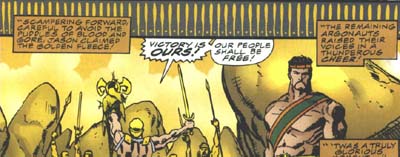
ARGONAUTS

Membership: Acastus, Aegisthus, Aethalides, Admetus, Amphiaraus, Amphidamas, Amphion, Ancaeus I, Ancaeus II, Argus (builder), Argus, Ascalaphus, Asterion/Asterius, Augeas, Autolycus, Butes, Caeneus, Calais, Canthus, Castor, Cepheus, Clytius, Coronus, Cytissorus, Dascylus, Deileon, Echion, Erginus, Eribatus/Eribotes, Euphemus, Euryalus, Eurybatus, Eurydamas, Eurytion/Eurytus, Hercules, Hylas, Ialmenus, Idas, Idmon, Iphicles, Iphitus, Jason (leader), Laocoon, Laertes, Leitus, Leodocus, Lynceus, Melampus, Melas, Meleager, Menoetius/Menoeceus, Mopsus, Nauplius (navigator), Oenopion, Oileus, the Old One, Orestus, Orpheus, Palaemon, Peleus, Peneleus, Periclymenus, Phalerus, Phanus, Phocus, Phlogius, Phrontis, Poeas, Pollux/Polydeuces, Polyphemus, Priasus, Staphylus, Talaus, Telamon, Theseus, Timon, Tiphys (steerman), Zetes, et al.
Purpose: The retrieval of the Golden Fleece with which would prove Jason’s worthiness to claim the throne of Iolcus (c.1250-1225 BC)
Affiliations: Apollo, Athena, Cybele, King Cyzicus of Fair, King Eurypylus of Libya, Glaucus, Hera, Queen Hypsipyle of Lemnos, Iris, King Lycus of the Mariadyndi, Medea of Colchis, King Nausithous of the Phaeacians, The Nereids, King Phineus of Salmydessus, Sersi, Triton
Enemies: King Aeson of Iolcus, King Aeetes of Colchis, the Akaana, King Amycus of the Bebryces, Charybdis, Flesh-Eating Giants, Medusa, Mikaboshi, The Sirens, Scylla, Stymphalian Birds, Talus
Base of Operations: The Argo, a sailing ship created by Argus, its builder; otherwise Mobile
First Appearance: Marvel Preview#10 (Winter 1977)
History: (Greek/Roman Myth)- The Argonauts were a band of adventurous young men who sailed with Jason, a Thessalian prince who was heir to the throne of Iolcus. His treacherous Uncle Pelias had usurped the throne and as Jason came to take the throne, he attested that he would surmount any adventure required to prove he was the true heir to the throne. Pelias challenged the lad to sail to Aea, the capital city of the kingdom of Colchis, to bring back the Golden Fleece, a sacred relic. Jason inquired at the oracle of Delphi if such a mission was possible. The goddess, Athena spoke to him and instructed him to build his boat from the oak trees around Dodona, the temple of Zeus. Argus, the best ship-builder of the time, built the boat for him while messengers sent word out for the best heroes of the area to come join the crew. Among these heroes were Hercules; the twins Castor and Pollux; the Athenian hero Theseus; the Thracian musician Orpheus; Nauplius, a son of Poseidon; Zetes and Calais, the twin sons of Boreas, the wind god; and many others. The Arcadian huntress Atalanta reportedly wanted to be a member, but Jason politely refused her believing there would be enough causes for dissension on the ship without her.
Many of the men wanted Hercules to lead the adventure, but he declined, claiming that none other than Jason deserved the honor. Argus accompanied them to handle repairs, and Tiphys, a Boeotian prince, controlled the helm. Nauplius used his knowledge and education from his father to act as navigator and Jason’s cousin, Acastus, followed along for the adventure. Following a sacrifice to Apollo for good luck, the ship sailed at dawn. Idmon, a son of Apollo who had prophetic gifts, meanwhile predicted that many of them, including himself, would not be coming home.
Their first stop was at the isle of Lemnos for fresh food and drink. Lemnos was controlled solely by women cursed by the goddess Venus with foul body odor because they had failed to honor her. Their men abandoned them to abduct mistresses from the mainland and were killed for the effort. Queen Hypsipyle treated the Jason and the Argonauts warmly at first hoping that she could get them to stay and live among them, but Hercules became bored waiting on the ship and rallied the men back to the ship with a speech of honor and glory. The Argonauts set sail once again with provisions, but Hypsipyle sired two sons by Jason named Euneus and Deipylus who lived to succeed her.
Orpheus meanwhile convinced Jason not to sail directly for the Hellespont, but north for Samothrace to be indoctrinated into its mysterious cults there for added protection on the trip. From there they landed at the port of Fair where King Cyzicus of the Doliones tribes offered them provisions and hospitality as per an oracle had instructed him to do. He showed them a proper place to camp for the night near the Bay of Chytus but forgot to tell them of the flesh-eating giants that lived there. Hercules slew the creatures while he was on guard duty with the help of the Argonauts and prevented anymore of the creatures from ever again attacking King Cyzicus’ kingdom. The wind, however, changed and in the blind dark, the Argonauts were forced back to port. As the Doliones rush to thank them, Jason and the Argonauts thought they were being attacked again and struck back, accidentally killing King Cyzicus in the process.
Storms stranded the Argo from leaving port for twelve days as the Argonaut Mopsus, who was a seer, suggested they travel overland to Mount Dindymene to sacrifice to the goddess Cybele to wash off their sin of the accidental murders. After the ritual, the storms abated and they put to sea once more.
Out at sea, Hercules accidentally broke his oar while rowing and the Argo had to drop anchor in nearby Mysia for repairs. As Hercules cut a new board, Hylas, his young traveling companion, went for fresh water and met a beautiful water goddess who abducted him to be her husband. The Argonaut Polyphemus heard his scream for help, but neither he nor Hercules found him. Hercules stayed behind to search for him as the Argonauts rushed to make the wind, but several among them would not leave him in the belief his strength was needed for more terrors. The sea-god Glaucus meanwhile instructed them to depart saying that Hercules’ departure was Zeus’ will to keep his son from going to Colchis and to keep his mind on his labors. The Mysians meanwhile kept to their promise to search for Hylas on behalf of the Argonauts.
Sailing for a day and a night, the Argonauts reached Cianian Bay where they encountered Amycus, king of the Bebryces and a son of Poseidon. It was the decision of Amycus to challenge all visitors to the land as the Argonaut Pollux, a son of Zeus, used his boxing skills to tire and them kill Amycus. The Bebryces then attacked and the rest of the Argonauts entered the battle and drove them inland. In the absence of the Bebryces, their enemies the Mariandyni took over the region.
(Greek Myth)- Taking to sea again, Zetes and Calais recommended to Jason that they put into port at nearby Salmydessus for provisions from their brother-in-law, King Phineus. They arrived to find him blinded and in exile for abusing his gift of prophesy from Zeus. The punishment was compounded by creatures called the Akaana that stole his food and defecated on his dining table. Incorrectly believing them to be the Harpies, Zetes and Calais used their godly powers to fly after and drive the creatures away from the area. The goddess Iris meanwhile promised the Argonauts that Phineus would no longer be terrorized by the creatures as the Akaana limped off to live out their days on the end of Crete.
(Greek-Roman Myth)- Grateful for their service, Phineus instructed the Argonauts how to get through the Clashing Rocks on their route. The Argonaut Euphemus, a son of Poseidon, dispatched a dove to test the rocks as they started rushing together. Barely surviving them, the dove flew on as the Argonauts quickly started rowing through on the rock’s recoil after the dove. The goddess Athena meanwhile realized they weren’t going to make it, so she reached down and pushed the rocks away with hand and pressed the Argo out of the way with her other hand. Released too soon, the rocks claimed part of the helm. Orpheus then recommended they land at the island of Thynias to offer thanks to the gods. According to Phineus, once they passed the rocks, the worst would be over.
The Argonauts soon landed at Cape Acherusias where they were welcomed by King Lycus of the Mariandyndi who rewarded them handsomely for defeating the Bebryces with whom his people had been enemies for so long. He was grieved to hear that Hercules had to be left behind since the son of Zeus had been a friend of his father. He sent his son Dascylus to replace Hercules. During their stay, Idmon of the Argonauts was killed by a boar while foraging for food and Tiphys the steersman fell sick and died. Poseidon’s son, Ancaeus, caught up with them after traveling over land to catch up with them and took over the steering.
At the Assyrian port of Sinope, the Argonauts were joined by compatriots of Hercules named Deileon, Autolycus, and Phlogius, who had become separated from him following his ordeal from the Amazons. They carried them to Themiscyra, the home of the Amazons, but a wind carried them to a tiny island sacred to Ares. They were attacked by his Stymphalian Birds, but Amphidamas recalled how Hercules had driven them off before and drove them off by creating a rattling noise that drove them off the island. They also rescued four shipwrecked brothers named Argus, Cytissorus, Phrontis, and Melas who had become stranded there while departing Colchis. Grandsons of King Aeetes of Colchis, their interest was in their ancestral lands in Greece. Jason convinced them to return with him to help him obtain the Fleece. He also plied them with questions on the layout and security of the land.
(Hercules And The Heart of Chaos#2 (fb, BTS))- At some point, Hercules re-joined the Argonauts.
(Greek-Roman Myth)- The Argonauts eventually landed at Colchis and docked at the river Phasis. They made a tribute to Gaea to look favorably upon them as the goddesses Hera and Athena planned their stragedy. Through Aphrodite, the two goddesses had Cupid smite Medea, the daughter of King Aeetes, with love for Jason. Guided by the four brothers, Jason, Telamon, and Augeas landed as Hera concealed them in a mist and lifted it so that Medea would discover Jason. Medea welcomed her nephews back as Aeetes confronted them under rules of hospitality and made much out of their relationships with the gods, especially Augeas whom he confused with the King of Elis, another son of Helios like himself. He promised to surrender the fleece willingly if Jason could yoke two fire-breathing bulls and sow the ground with the teeth from a dragon. Jason would then have to defeat the men that would spring magically up from the teeth to claim the fleece. As Jason took a night to prepare for the grueling task, Aeetes provoked his kinsman against the Argonauts by accusing them of being invaders and pirates. Warned by his father of treachery from his own family, Aeetes also knew that removal of the fleece from his kingdom would lead to his death.
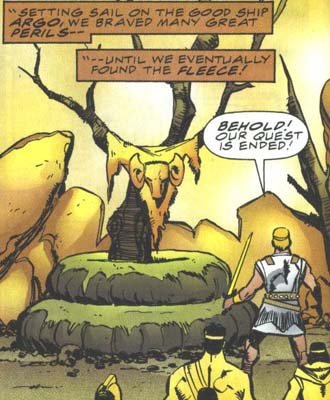
(Greek-Roman Myth/Hercules and the Heart of Chaos#2 (fb))- Medea, however, began using witchcraft shown to her by Hecate to favor Jason. She gave him a drug to poison the dragon and anointed him in the rites of Hecate to protect him from harm. The next morning, Jason succeeded in yoking the bulls and plowing the field with the dragon’s teeth as men sprang from the teeth in the soil. He tossed a rock between the warriors to get them to fight amongst themselves. He then slew the survivors.
Dissatisfied with the results, Aeetes plotted his next move as his daughter Medea hurriedly escorted Jason and the Argonauts to the site of the Golden Fleece. Accidentally waking the dragon that guarded it, the Argonauts began fighting it in order to gain the fleece. As Medea used her magic to drug the dragon, Hercules simultaneously impaled it. The victorious Argonauts now hurried back to the Argo as Medea tried to cover their retreat from her father and the armies of Colchis. The Argonauts Iphitus and Clytius were slain in the battle as the Argonaut Meleager killed Aeetes with an arrow. Unable to stay because of her treachery, Medea joined Jason and the Argonauts from their flight from Colchis.
After returning Dascylus to his homeland, the Argonauts sailed for the mouth of the Danube. Absyrtus, Medea’s brother, had reached it before them and promised they could keep the fleece if they surrendered Medea for her betrayal to their father. Pretending that she had been kidnapped, Medea met with her brother, but instead lead him into a trap to be murdered by Jason. She then scattered her brother’s dismembered corpse to the ocean as the goddess Hera created a storm to confuse and scatter the following Colchian fleet.
(Theoretical/Greek-Roman myth)- Medea now needed to be purified for the murder of her brother. The Argonauts sailed up the Danube and followed another river to the Adriatic Sea. They then braved their way toward Aeaea, the island home of the Eternal Sersi who Medea believed to be her aunt, the goddess Circe. Offended by the full story of her treachery, Sersi absolved Medea of her sins, but requested the Argonauts remove themselves from her home rather than share in her hospitality.
(Greek-Roman Myth)- In order to return the Argonauts safely to Iolcus, Hera requested the help of Thetis and the Nereids. Thetis at first refused because her ex-husband Peleus was one of the Argonauts, but then Hera told her that Medea would be wife to her son, Achilles, in the afterlife. By now, the Argonauts had reached the Isle of the Sirens whose singing was drowned out by the singing of the Argonaut Orpheus. The Argonaut Butes, however, jumped ship to swim ashore. Thetis and the Nereids guided the Argo’s oar between Scylla and Charybdis and then past the Wandering Rocks near Hephaestus’s forges on the island of Aetna.
Near Drepane, the Argonauts put ashore for provisions, but were confronted by members of the Colchian fleet who had ran aground there by storms. Demanding the return of Medea, they turned to local King Nausithous to arbitrate, but he left the decision to his wife. Queen Arete who decided that if Jason and Medea had already consummated their love, they could not be divided. The Colchians left defeated as Jason and Medea married on the island.
Nearing Greece, a storm swept the Argo toward and beached it at Libya. The Nereids then appeared again and revealed they had not paid homage to the Argo for carrying them so far and they likewise carried her overland to Lake Tritonis nearby. The Hesperides, daughters of Atlas the Titan, provided them with provisions. As Canthus and Mopsus tried to gather more food, a shepherd named Caphaurus--thinking Canthus was stealing his sheep--killed him and Mopsus died from snakebite from a serpent created a generation before by Medusa’s blood. After proper burials, the Argonauts returned to the Argo where Eurypylus, King of Libya and a son of Poseidon, gave them a clod of dirt to lead their way to Iolcus. The Argonaut Euphemus who was also a son of Poseidon accepted it. After a tribute to Poseidon, the Argonauts boarded the Argo, and the sea-god Triton pushed her from the lake and back out to sea. Following his instructions, Euphemus cast the dirt out to sea and it led back them to Greece.
Nearing Crete, the Argonauts attempted to land for provisions, but were driven out to sea by the bronze giant Talos which Zeus had placed there to protect the island. Landing in secret, the Argonauts sought out Talos to prevent him from sinking their ship. Using her psychic senses, Medea drew Jason’s attention to a weakness in Talos’s ankle. The Argonaut shot him there with an arrow as the giant fell dead.
Establishing a shrine to Athena on the island before departing, the Argonauts sailed forward at night. They lost sight of the clod of dirt in the darkness as it became part of the island of Thera. Jason preyed to Apollo for help and the god shot a beam of light across the sky for them to follow. Once they recognized familiar water, they dedicated the island Anaphe to Apollo for helping them. They celebrated on the island of Aegina, home of Peleus, and then returned to Iolcus.
Once home, Medea aided Jason in deposing Pelias from the throne. She used her spells to rejuvenate Jason’s father, Aeson, and then explained to Pelias’s daughters how they could do the same for Pelias. She added one more extra proviso that they turn up the heat, and as a result Pelias was burned to death. For his role in Pelias’s death, Jason was forced into exile with Medea, who they refused to accept, and he surrendered his throne which was his birthright to his cousin Acastus. Medea, who had been invited to rule her ancestral Corinth, took Jason with her there where they lived together for ten years.
The Argonauts had several other adventures with and without Jason who soon had other problems. They partook on the hunt for the Calydonian Boar and teamed up with Hercules against Troy and invasions on the Amazons. Hercules meanwhile discovered that Zetes and Calais supported the decision to abandon him at Mysia and killed them in a rage. Jason eventually had to divorce Medea because their children had no rights as long as they remained married.
(Marvel Preview#10 (fb))- As a guest of King Kreon of Pylos, Jason was asked by his daughter Alceste to be shown the sport of bull-leaping. Hercules was also in attendance and leapt in to prevent fatal injury, but Kreon was so dishonored he ordered Jason to bring him the gold of the Gorgon as penance. Hercules joined Jason this time for the adventure.
(Marvel Preview#10 (fb))- Hercules used a ring Alceste had given to Jason to restore the Argo and finance their new adventure.
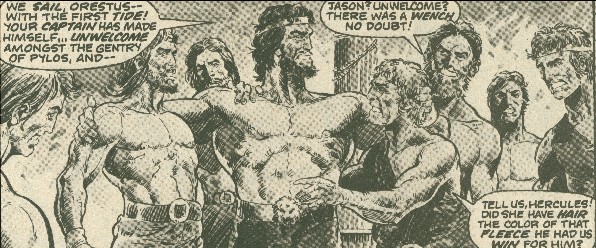 (Marvel
Preview#10)- Sailing for the Isle of Fear, the Argonauts landed
and Hercules lead the way to the mountain lair of Medusa.
Attacked by griffins en-route, Hercules fought them off as the
Old One defended their ship on the beach from a giant crab.
Hercules’ band meanwhile reached Medusa’s lair as she
tempted Jason with an apple and turned him to stone with her gaze.
As the Old One rushed to reveal that the ship was saved from a
giant crab at the expense of the crew, he discovered Medusa about
to slay Hercules and killed her with an arrow. As he died from
the exertion, Jason returned to normal with all the other
petrified victims of the Gorgon. After burying the Old One with
honors, Jason and Hercules seized Medusa’s treasures and
flew ahead together on her winged horse with their new crew now
made up from Medusa’s victims restored to life on the ship.
In Pylos, Kreon reached greedily into the sack which Jason had
brought him and was bitten by a snake hiding within it. With his
death, Jason claimed Alceste as his new bride and the throne of
Pylos for himself.
(Marvel
Preview#10)- Sailing for the Isle of Fear, the Argonauts landed
and Hercules lead the way to the mountain lair of Medusa.
Attacked by griffins en-route, Hercules fought them off as the
Old One defended their ship on the beach from a giant crab.
Hercules’ band meanwhile reached Medusa’s lair as she
tempted Jason with an apple and turned him to stone with her gaze.
As the Old One rushed to reveal that the ship was saved from a
giant crab at the expense of the crew, he discovered Medusa about
to slay Hercules and killed her with an arrow. As he died from
the exertion, Jason returned to normal with all the other
petrified victims of the Gorgon. After burying the Old One with
honors, Jason and Hercules seized Medusa’s treasures and
flew ahead together on her winged horse with their new crew now
made up from Medusa’s victims restored to life on the ship.
In Pylos, Kreon reached greedily into the sack which Jason had
brought him and was bitten by a snake hiding within it. With his
death, Jason claimed Alceste as his new bride and the throne of
Pylos for himself.
(Hulk: Hercules Unleashed (fb))- On another
adventure with Jason and the Argonauts, Hercules was chided by
Jason for wanting to hurry home to be with his wife. As Jason
sited the thrill of adventure, Hercules revealed the pleasure of
a good wife and home waiting for him. Hoisted up into the lines
of the ship, Hercules was confronted by the face of his half-sister,
Athena, in the oak mast as she warned him he would be killed
twice in his life and that both times would involve a green
monster. Just then, the sea boiled with great fury and the Hydra
attacked as the Argonauts fought together to defeat it and
protect their ship.
(Ares#3) - Jason and the Argonauts were later reincarnated to serve in the armies of Olympus as they fought the demons of Japan led by Mikaboshi.
Comments: Adapted By William Mantlo and Val Mayerik
This account of the Argosy (Story of the Argonauts) is the best likely scenario to explain the multiple aspects and facets of the myriad stories as well as the conflicting details within them as well as the added incidents of the Marvel Universe.
In fact, almost all the cities along the Argonauts route reportedly had stories that tied into their adventure. The same thing goes for the wanderings of Hercules, Odysseus and Aeneas.
In the Marvel Universe, Hercules seems to remember fondly his adventures with the Argonauts. It doesn’t take much for him to relate and spin a tale from those days to anyone willing or unwilling to listen. Furthermore, much of his stories with them must be taken with a grain of salt because of his tendency to embellish the facts. The major discrepancy is that in the myth of the Argonauts Hercules was not actually present for the taking of the fleece. He doesn’t even appear in the history again until after the Argonauts meet the Hesperides and are informed by them of a recent encounter with a big brute who recent took some apples. Recognizing “the big brute” as Hercules on his Eleventh Labor, it was during a search for Hercules that Canthus and Mopsus are killed in accidents. In Hercules: Heart Of Chaos, Hercules could be inserting himself in the events he had only heard from other sources, but this is hypothetical at best. In the meantime, this version will include him for most of the full adventure.
Concerning the story of the Harpies, in the original myth, the goddess Iris asked the Argonauts to spare them because they were her sisters and that they served as the hounds of Zeus. She thereafter swore by the Styx that they would never again plague Phineus.
The so-called Clashing Rocks (also called the Symplegedes) was located in the Bosporus (the hinge of the continents of Europe and Asia) and was probably actually an earthquake that Phineus predicted. The majority of the other creatures such as Charybdis and Scylla, however, are believed by modern mythologians to actually be a secret code directing sailors to points west of Ancient Greece than the actual creatures themselves.
There have been two movies based on the Argosy; the first “Jason and the Argonauts” (1963) is by far the most enjoyable and is possibly the closest to the actual story. Highlighted by the special effects of Ray Harryhausen, it starred Todd Armstrong as Jason and Nancy Kovak as Medea. (All of Armstrong’s lines ended up redubbed prior to its release.) In 2000, actor Jason London took the title role in a more extravagantly visual film, which unfortunately fell a bit further from the legend. In the “Hercules, The Legendary Journeys” TV-Series, Jason was portrayed with even less basis on the myth by Jeffrey Thomas. And then there is the Seventies TV-Series “Jason of Star Command” with Craig Little which is something else altogether.
The Golden Fleece has been seen in a flashback in Hercules: Heart of Chaos#2. It has also been seen in the DC Universe as the cape of a Greek hero named Aristides Demetrios who became the Olympian. Endowed with the power of the Argonauts, he later became a member of the Global Guardians.
Several texts disagree on the route the Argonauts took on their return to Greece. Pindar suggested they traveled down the Phasis toward the Persian Gulf, around ancient Arabia and then up the Red Sea. Timaeus argued they took the Don up as far as they could and then over a portage that entered into a river to the Baltic Sea. From there, they sailed through the North Sea and back through the Pillars of Hercules at the Straits of Gibraltar. While none of these water routes would be possible in modern years, the Danube is most generally agreed upon as the most traditional route.
It is not for certain whom the Medusa was that the Argonauts encountered on the Isle of Fear since she was almost definitely killed by Perseus two generations prior. See the Medusa profile for further discussion on this.
For that matter, it is not sure why the Hydra would re-appear at sea for the Argonauts if he had killed it on his second labor and dipped his arrows in its blood. Possibly, it just limped off from its wounds, re-gathered its strength over several years and then sought out Hercules to even the score.
Of the Argonauts listed below, only Eurytus has any mythological significance as an Argonaut, but he has been confused with the mythological King of Oechalia who was actually responsible for teaching Hercules in the use the bow and arrow. Jason will be getting his own future entry.
It is unknown as to who the Old One actually is. He could be Argus, the builder of the first Argo, or perhaps by the rules of artistic license, Perseus himself looking for one last adventure from his great-grandson, Hercules.
The Akaana who fought the Argonauts are the same as the Akaana man-bats who encountered Solomon Kane in REH's Wings in the Night, adapted in Savage Sword of Conan#53/4; This is confirmed in the Solomon Kane chronology section of SSoC#219-220.
A rather interesting take on the story of the Argonauts appears in GI Joe: The Animated Series in an episode called “GI Joe and the Golden Fleece.” After an extra-terrestrial artifact sends factions of both GIJoe and Cobra back in time, both teams try to outrace each other in retrieving the object to get back to their own time. Sgt. Slaughter is mistaken for Hercules, Lifeline for Asclepius (who’s not really an Argonaut but that’s creative license for you), the Baroness in a glider as a Harpy and the Tomahawk copter on a raft as the Argo. A boy named Jason tags along on the adventure. The Joes are even worried about screwing up history, but the funny part is that Sgt. Slaughter “recognizes” King Augeas from “the history books.” (I’ve never known a history book that gave credence to any of the myths.) Sgt. Slaughter even deviates from the mission to perform Hercules’ labor of cleaning the Augean Stables, which is otherwise attributed to the Eternal Gilgamesh who was often mistaken for Hercules. The latter point is probably moot because there’s no clear indication to confirm that the GIJoe adventures, comic or otherwise, take place in the known Marvel Universe.
by Will U and Prime Eternal
CLARIFICATIONS:
The Argonauts and their ship, the Argo, have no
known connection to:
The Argonaut Aegisthus is not to be confused with:
The Argonauts known as Ancaeus are not to be confused with:
The Argonaut Augeas is not to be confused with:
The Argonaut Autolycus is not to be confused with:
The Argonaut Cepheus is not to be confused with:
The Goddess Cybele possibly should not be confused with:
The Argonaut Eurytus (also called Eurytion) should not be confused with:
The Argonaut Orpheus is not to be confused with:
The Argonaut Laocoon is not to be confused with:
The Argonaut Lynceus is not to be confused with:
The Argonaut Melampus is not to be confused with:
The Argonaut Menoetius is not to be confused with:
The Old One is not to be confused with:
The Argonaut Orestus is not to be confused with:
The Argonaut Polyphemus is not to be confused with:
 Aegisthus
was a rather late member of the Argonauts. He joined the
group just before the adventure toward the Isle of Fear.
Traveling in land with Jason and Hercules, he was first
to notice the griffins that attacked them. Hercules
fought it off to save his life, but several of the other
men were either ripped apart or crushed under its mighty
body. Watching as one of the beasts carried off Jason and
Hercules, he raced back to the Argo just as it was
attacked by a giant crab. Rallied by the Old One, he
fought off the beast for as long as he could before he
was killed.
Aegisthus
was a rather late member of the Argonauts. He joined the
group just before the adventure toward the Isle of Fear.
Traveling in land with Jason and Hercules, he was first
to notice the griffins that attacked them. Hercules
fought it off to save his life, but several of the other
men were either ripped apart or crushed under its mighty
body. Watching as one of the beasts carried off Jason and
Hercules, he raced back to the Argo just as it was
attacked by a giant crab. Rallied by the Old One, he
fought off the beast for as long as he could before he
was killed.
--Marvel Preview#10
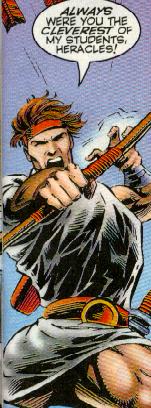
Eurytus, also called Eurytion, was the son of King Irus of Phthia. Eurytus reportedly was a student of the Centaur Chiron along with Jason, Hercules and Peleus. Eurytus even tutored Hercules in how to fire and use a bow and arrow. Several years later, his father purified Peleus for the murder of his brother and even gave Eurytus’s sister, Antigone, as a wife along with a third of the kingdom. Both Eurytus and Peleus were among Jason’s original Argonauts for the Golden Fleece and in other adventures.
Several years later in the hunt for the Calydonian Boar, Eurytus was accidentally killed by Peleus in a hunting accident.
--Greek/Roman Myth, Hulk: Hercules Unleashed
Eurytus' physical appearance was
meant to evoke that of Hawkeye in Hulk: Hercules
Unleashed
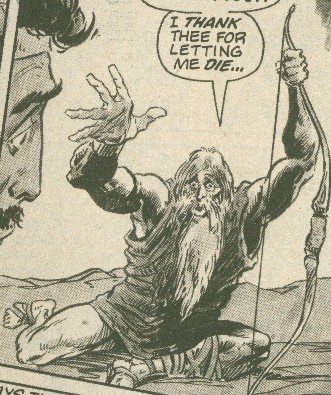 The
Old One was possibly the eldest member of the
original Argonauts. He considered it an honor when
Hercules invited him on one last adventure this time to
the Isle of Fear. Left behind to watch the ship as Jason
and Hercules led a team in land to scout the island, he
was distracted when the men returned a while later
screaming that they were attacked by griffins. Just then,
a giant crab surged from the bay and attacked the ship
terrifying the men. He ordered them to remember they were
Argonauts and afraid of nothing. They began fighting it
with everything they had as the Old One was knocked into
the water. When he looked again, the ship was safe, but
everyone else had lost their lives. He ran in land to
search for Jason and Hercules and came upon the scene
just as Medusa attempted to kill Hercules. He killed her
with an arrow to save Hercules, but the strain was too
much for him and he fell over from the stress on his
heart. As he died, he thanked Hercules for letting him
die as a warrior instead of as an old man
The
Old One was possibly the eldest member of the
original Argonauts. He considered it an honor when
Hercules invited him on one last adventure this time to
the Isle of Fear. Left behind to watch the ship as Jason
and Hercules led a team in land to scout the island, he
was distracted when the men returned a while later
screaming that they were attacked by griffins. Just then,
a giant crab surged from the bay and attacked the ship
terrifying the men. He ordered them to remember they were
Argonauts and afraid of nothing. They began fighting it
with everything they had as the Old One was knocked into
the water. When he looked again, the ship was safe, but
everyone else had lost their lives. He ran in land to
search for Jason and Hercules and came upon the scene
just as Medusa attempted to kill Hercules. He killed her
with an arrow to save Hercules, but the strain was too
much for him and he fell over from the stress on his
heart. As he died, he thanked Hercules for letting him
die as a warrior instead of as an old man
--Marvel Preview#10
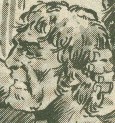 Orestus
was a rather late member of the Argonauts having joined
them just prior for the search for the Gold of the Gorgon
on the Isle of Fear. He remained on the boat as Jason and
Hercules took a small team to scout the island. As
Aegisthus and a few others fled back to the ship after an
attack by Griffins, a giant crab attacked the ship and
the Old One rallied them to defend the ship. Orestus lost
his life in the attack.
Orestus
was a rather late member of the Argonauts having joined
them just prior for the search for the Gold of the Gorgon
on the Isle of Fear. He remained on the boat as Jason and
Hercules took a small team to scout the island. As
Aegisthus and a few others fled back to the ship after an
attack by Griffins, a giant crab attacked the ship and
the Old One rallied them to defend the ship. Orestus lost
his life in the attack.
--Marvel Preview#10
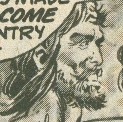 Timon
was a rather late member of the Argonauts having joined
them just prior for the search for the Gold of the Gorgon
on the Isle of Fear. He remained on the boat as Jason and
Hercules took a small team to scout the island. As
Aegisthus and a few others fled back to the ship after an
attack by Griffins, serpents attacked the ship and the
Old One rallied them to defend the ship. Timon lost his
life in the attack.
Timon
was a rather late member of the Argonauts having joined
them just prior for the search for the Gold of the Gorgon
on the Isle of Fear. He remained on the boat as Jason and
Hercules took a small team to scout the island. As
Aegisthus and a few others fled back to the ship after an
attack by Griffins, serpents attacked the ship and the
Old One rallied them to defend the ship. Timon lost his
life in the attack.
--Marvel Preview#10
Images taken from:
Argonauts - Hercules: Heart of Chaos#2, pg. 4, middle
left panel
Argonauts - Hercules: Heart of Chaos#2, pg. 6, bottom
panel
Argonauts - Marvel Preview#10, pg. 51, middle panel
Aegisthus - Marvel Preview#10, pg. 47, bottom left panel
Eurytus - Hulk: Hercules Unleashed, page 5, panel 4
Orestus - Marvel Preview#10, pg. 51, middle panel right
Timon - Marvel Preview#10, pg. 51, top panel right
The Old One - Marvel Preview#10, pg. 57, top right
Marvel Preview#10 (Winter 1977) - Bill Mantlo (writer), Val Mayerik (artist), John Warner & Ralph Macchio (editor)
Hulk: Hercules Unleashed (October, 1996) - Peter David (writer), Mike Deodato Jr. (pencils/inks), Mark Gruenwald (editor)
Hercules: Heart of Chaos#2 (September, 1997) - Tom DeFalco (writer), Tom DeFalco & Ron Frenz (pencils), Pat Olliffe (inks), Tom Brevoort (editor)
Ares#3 (May, 2006) - Michael Avon Oeming (writer), Travel Foreman (penciler), Derek Fridolfs (inker), Warren Simons (editor)
First Posted: 07/17/2004
Last updated: 07/10/2006
Any Additions/Corrections? please let me know.
Non-Marvel Copyright info
All other characters mentioned or pictured are ™
and © 1941-2099 Marvel Characters, Inc. All Rights
Reserved. If you like this stuff, you should check out
the real thing!
Please visit The Marvel Official Site at: http://www.marvel.com
Special Thanks to www.g-mart.com for hosting the Appendix, Master List, etc.!